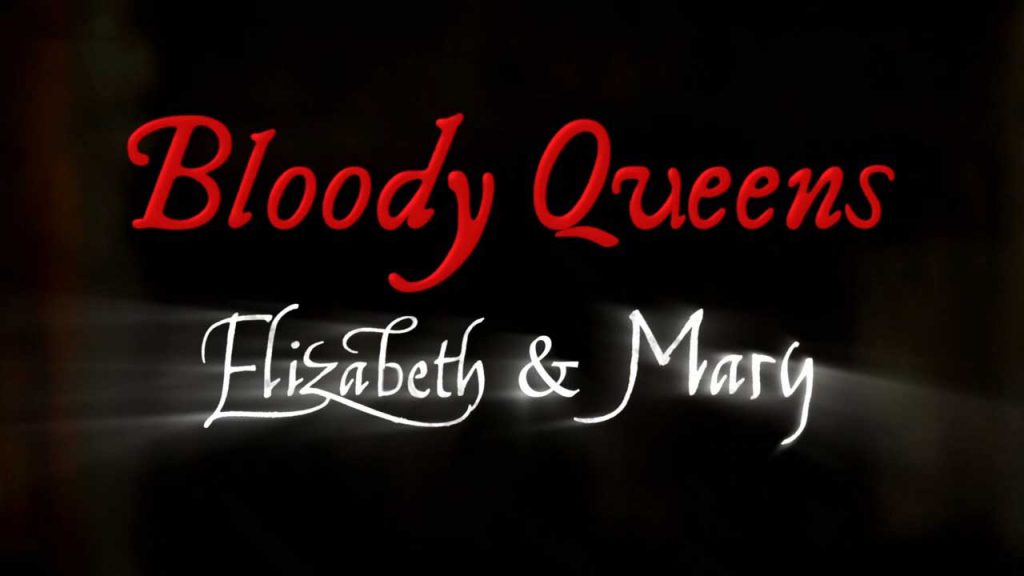Bloody Queens: Elizabeth and Mary – Drama revealing the intimate and ultimately deadly relationship between Queen Elizabeth I and Mary, Queen of Scots, using the words of the two queens and their courtiers.
Of all the dangers Elizabeth I had to survive – the Spanish Armada, a Catholic continent plotting against her incessantly, restless nobles uneasy at serving a queen who refused to marry – none was so personally intense as her rivalry with another woman – her cousin and fellow queen, Mary, Queen of Scots. This was her longest, most gruelling battle – lasting over two decades, it threatened to tear apart both Elizabeth and her kingdom. In the end, it would force her to make the hardest decision of her life.
The two queens stared across the ultimate divides of their time: Protestant and Catholic, Tudor and Stuart, English and Scottish. Their fascination with one another grew into the greatest queenly face-off in our entire history. And yet, in 26 years of mutual obsession, they never actually met. Their confrontation was carried out through letters – a war of words so heartfelt and revealing that the two queens’ passions can still be felt.
For the first time on television, this chronicle of love turned to hatred, of trust betrayed by plot and bloodshed, is dramatised purely from the original words of the two queens and their courtiers. Expert historians examine, interpret and argue over the monarchs’ motives for their ‘duel to the death’ – for in the end only one queen could survive such emotional combat.
Bloody Queens: Elizabeth and Mary
Elizabeth I
Elizabeth I was Queen of England and Ireland from 17 November 1558 until her death in 1603. Sometimes referred to as the Virgin Queen, Elizabeth was the last of the five monarchs of the House of Tudor.
Elizabeth was the daughter of Henry VIII and Anne Boleyn, his second wife, who was executed when Elizabeth was 21⁄2 years old. Anne’s marriage to Henry was annulled, and Elizabeth was declared illegitimate. Her half-brother Edward VI ruled until his death in 1553, bequeathing the crown to Lady Jane Grey and ignoring the claims of his two half-sisters, the Roman Catholic Mary and the younger Elizabeth, in spite of statute law to the contrary. Edward’s will was set aside and Mary became queen, deposing Lady Jane Grey. During Mary’s reign, Elizabeth was imprisoned for nearly a year on suspicion of supporting Protestant rebels.
Upon her half-sister’s death in 1558, Elizabeth succeeded to the throne and set out to rule by good counsel. She depended heavily on a group of trusted advisers led by William Cecil, whom much later she created 1st Baron Burghley. One of her first actions as queen was the establishment of an English Protestant church, of which she became the supreme governor. This Elizabethan Religious Settlement was to evolve into the Church of England. It was expected that Elizabeth would marry and produce an heir; however, despite numerous courtships, she never did. She was eventually succeeded by her first cousin twice removed, James VI of Scotland; this laid the foundation for the Kingdom of Great Britain. She had earlier been reluctantly responsible for the imprisonment and execution of James’s mother, Mary, Queen of Scots.
Mary, Queen of Scots
Mary, Queen of Scots, also known as Mary Stuart or Mary I of Scotland, was Queen of Scotland from 14 December 1542 until her forced abdication in 1567.
The only surviving legitimate child of James V of Scotland, Mary was six days old when her father died and she acceded to the throne. During her childhood, Scotland was governed by regents, first by the heir to the throne, James Hamilton, Earl of Arran, and then by her mother, Mary of Guise. In 1548, she was betrothed to Francis, the Dauphin of France, and was sent to be brought up in France, where she would be safe from invading English forces during the Rough Wooing. Mary married Francis in 1558, becoming queen consort of France from his accession in 1559 until his death in December 1560. Widowed, Mary returned to Scotland in August 1561.
Following the Scottish Reformation, the tense religious and political climate that Mary encountered on her return to Scotland was further agitated by prominent Scots such as John Knox, who openly questioned whether her subjects had a duty to obey her. The early years of her personal rule were marked by pragmatism, tolerance, and moderation. She issued a proclamation accepting the religious settlement in Scotland as she had found it upon her return, retained advisers such as James Stewart, Earl of Moray, and William Maitland of Lethington, and governed as the Catholic monarch of a Protestant kingdom.




